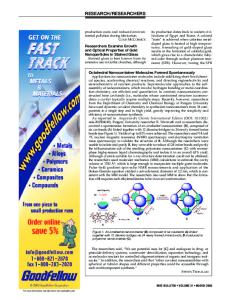Morphology and Optical Properties of a Composite Material Based on Gold Nanoparticles and Nonstoichiometric Silicon Oxid
- PDF / 1,089,663 Bytes
- 4 Pages / 612 x 792 pts (letter) Page_size
- 96 Downloads / 352 Views
logy and Optical Properties of a Composite Material Based on Gold Nanoparticles and Nonstoichiometric Silicon Oxide A. O. Zamchiya,b*, S. V. Starinskiya,b, and E. A. Baranova a
Kutateladze Institute of Thermophysics, Siberian Branch, Russian Academy of Sciences, Novosibirsk, 630090 Russia b Novosibirsk State University, Novosibirsk, 630090 Russia *e-mail: [email protected] Received May 8, 2020; revised May 19, 2020; accepted May 19, 2020
Abstract—The morphology, structure, and optical properties of a composite material based on gold nanoparticles and thin film of amorphous nonstoichiometric silicon oxide (a-SiOx, x = 1.8) have been studied for the first time. Based on the obtained experimental data, it is established that a-SiO1.8 layer provides conformal coating of spherical nanoparticles. An analytical model based on the Mie theory adequately describes the experimental optical properties of gold nanoparticles and composite material in the UV spectral range, as well as the observed variation of the plasmonic peak amplitude during the formation of the composite material. Keywords: gold nanoparticles, thin films, nonstoichiometric silicon oxide, localized plasmon resonance, transmission electron microscopy. DOI: 10.1134/S1063785020080283
Nanoparticles (NPs) of noble metals (gold, silver, etc.) exhibit pronounced plasmonic properties in the visible wavelength range [1]. The practical use of plasmonic NPs frequently assumes their incorporation into a dielectric or semiconductor matrix with certain functional and/or protective properties [2, 3]. The obtained composite materials are widely used for the creation of chemical and biological sensors [4], solar cells [5], and bactericidal and antiviral coatings [6]. The presence of a matrix hinders the influence of ambient atmosphere on incorporated NPs and prevents their degradation, thus favoring the retention of unique optical properties of the material [3]. At the same time, the optical properties of the matrix and overall morphology of the composite significantly influence the resonance frequency of localized plasmons [2, 3, 7], It should be noted that the synthesis of a composite material can involve irreversible processes leading to the deterioration, or even elimination, of plasmonic properties, diffusion of NPs from the matrix to surface, agglomeration of NPs, and the formation of compounds from elements of the matrix and NPs (in particular, due to a high temperature of synthesis) [7, 8]. In addition to developing empirical approaches to optimization of the process of composite material synthesis, the interest of researchers is focused on improving methods for the calculation of these systems. At present, there are numerous analytical [9] and numerical [10] approaches to description of the scattering of radiation incident on nanodimensional
objects. However, the volume of experimental data available for the characteristics of a material under consideration is frequently insufficient for full-scale verification of a proposed theoretical model. In the present work,
Data Loading...





